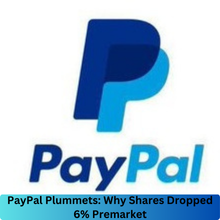
PayPal has been in the spotlight recently, and not for the best reasons. After releasing its third-quarter earnings, the company saw its stock drop over 6% in premarket trading. While the earnings per share surpassed expectations, revenue figures fell slightly short, stirring up concerns among investors. Let’s dive into the details behind these numbers and what they mean for PayPal moving forward.
Earnings Summary
Key Financial Metrics
In the latest earnings report, PayPal reported adjusted earnings per share (EPS) of $1.20, beating the expected $1.07. However, when it came to revenue, the numbers didn’t align as neatly. PayPal’s revenue came in at $7.85 billion, falling just shy of the anticipated $7.89 billion. This shortfall in revenue is what triggered the market’s negative reaction.
Year-over-Year Comparisons
When we look back at last year, PayPal saw a 6% increase in revenue compared to the same quarter in the previous year, which stood at $7.42 billion. Meanwhile, net income remained stable at around $1.01 billion, or 99 cents per share, compared to $1.02 billion, or 93 cents per share, a year prior. While these figures indicate some growth, the revenue miss raises eyebrows.
Leadership Changes and Strategic Focus
CEO Alex Chriss’s First Year
This earnings report marks the first for CEO Alex Chriss since he completed a year in his role. Chriss took over during a turbulent period for PayPal, characterized by stiff competition and declining revenue percentages. His focus has been on steering the company towards more profitable growth.
Shift Towards Profitable Growth
One of Chriss’s main strategies has been to better monetize existing acquisitions, such as Braintree and Venmo. These platforms are integral to PayPal’s overall strategy, aiming to harness their full potential to enhance revenue streams.
Total Payment Volume Insights
Performance Metrics
Total payment volume (TPV) is a crucial indicator of PayPal’s performance in the digital payments landscape. In Q3, TPV rose by 9%, reaching $422.6 billion, just slightly exceeding analysts’ expectations of $422.5 billion.
Analyst Expectations vs. Reality
Despite this increase, the discrepancy between revenue expectations and actual results raises questions. Analysts had projected a more robust performance, which is a recurring theme in PayPal’s recent reports.
Operating Margins and Active Accounts
Margin Performance
PayPal’s operating margin came in at 18.8%, surpassing the estimate of 17.4%. This indicates a solid foundation for the company’s core business, even amid revenue challenges.
Growth in Active Accounts
The company reported having 432 million active accounts, up 1% from last year and slightly above the estimated 430.5 million. This modest growth in user base shows PayPal’s resilience in attracting new customers, despite competitive pressures.
Challenges and Future Outlook
Declining Take Rate
One concerning trend is the decline in PayPal’s take rate, which slipped to 1.86% from 1.91% a year ago. This decline suggests that PayPal is keeping less revenue from each transaction, which could impact future profitability.
Q4 Guidance
Looking ahead to Q4, PayPal anticipates “low single-digit growth,” much lower than analysts’ expectations of 5.4% growth to reach $8.46 billion in revenue. The cautious guidance reflects a strategic shift towards a “price-to-value strategy” and prioritizing profitable growth.
Also read: SoFi Hits $697M Revenue! What’s Next for Investors
Innovations and Product Launches
Fastlane and Enhanced Services
One significant initiative introduced during this quarter is Fastlane, a product designed to reduce cart abandonment at checkout. By streamlining the payment process, Fastlane aims to compete directly with popular alternatives like Apple Pay.
PayPal Everywhere Initiative
In addition to Fastlane, PayPal launched the PayPal Everywhere initiative, offering 5% cash back for users utilizing a PayPal debit card within the mobile app. This has resulted in approximately 1 million new debit card enrollments, signaling strong interest in this cash-back program.
Venmo’s Performance and Partnerships
Growth Metrics
Venmo, a subsidiary of PayPal, also reported a solid performance, with total payment volume increasing by 8% from the previous year. This growth is crucial for PayPal as it continues to diversify its revenue sources.
Key Partnerships
Partnerships with major businesses such as DoorDash, Starbucks, and Ticketmaster have allowed Venmo to expand its acceptance as a payment method, enhancing its visibility and utility in the marketplace.
Also read: Dodgers vs. Yankees Game 3: Shocking Live Updates Revealed
Conclusion
In summary, while PayPal has shown resilience in certain areas, the recent earnings report highlights some significant challenges. The revenue miss has led to a premarket drop in stock price, prompting questions about future growth and profitability. As PayPal navigates its transformation under Alex Chriss’s leadership, the focus on innovations and strategic partnerships will be crucial in determining its trajectory moving forward.
FAQs
Why did PayPal’s stock drop after the earnings report?
The stock dropped primarily due to a revenue miss, despite beating earnings per share expectations.
What is the significance of total payment volume?
Total payment volume indicates how well PayPal is performing in the digital payments space, reflecting overall user activity.
How is PayPal addressing competition in the market?
PayPal is introducing new products like Fastlane and enhancing existing services to retain and attract more users.
What does the decline in take rate mean for PayPal?
A declining take rate suggests that PayPal is earning less from each transaction, which could impact future revenue and profitability.
What are analysts expecting for PayPal in the upcoming quarter?
Analysts expect low single-digit growth, which is lower than the company’s previous performance and projections.

